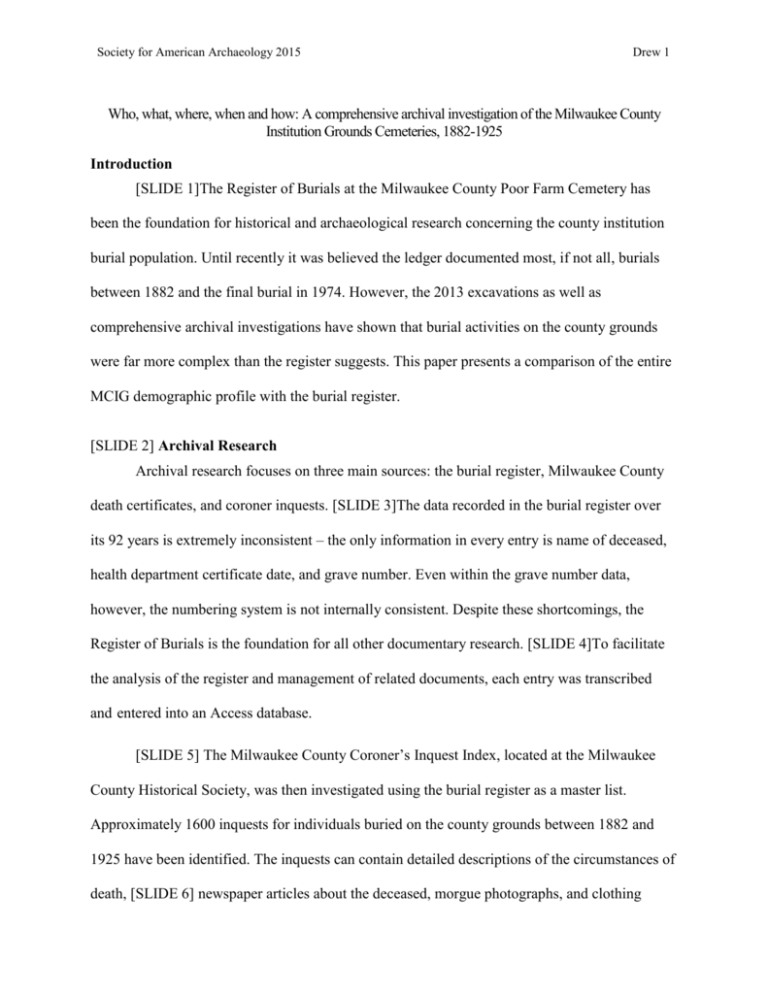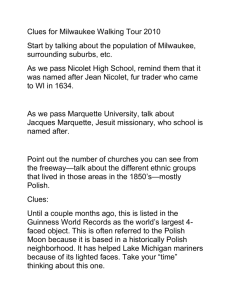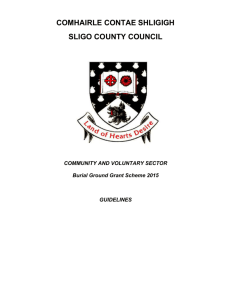Drew_SAA_2015 - University of Wisconsin–Milwaukee
advertisement

Society for American Archaeology 2015 Drew 1 Who, what, where, when and how: A comprehensive archival investigation of the Milwaukee County Institution Grounds Cemeteries, 1882-1925 Introduction [SLIDE 1]The Register of Burials at the Milwaukee County Poor Farm Cemetery has been the foundation for historical and archaeological research concerning the county institution burial population. Until recently it was believed the ledger documented most, if not all, burials between 1882 and the final burial in 1974. However, the 2013 excavations as well as comprehensive archival investigations have shown that burial activities on the county grounds were far more complex than the register suggests. This paper presents a comparison of the entire MCIG demographic profile with the burial register. [SLIDE 2] Archival Research Archival research focuses on three main sources: the burial register, Milwaukee County death certificates, and coroner inquests. [SLIDE 3]The data recorded in the burial register over its 92 years is extremely inconsistent – the only information in every entry is name of deceased, health department certificate date, and grave number. Even within the grave number data, however, the numbering system is not internally consistent. Despite these shortcomings, the Register of Burials is the foundation for all other documentary research. [SLIDE 4]To facilitate the analysis of the register and management of related documents, each entry was transcribed and entered into an Access database. [SLIDE 5] The Milwaukee County Coroner’s Inquest Index, located at the Milwaukee County Historical Society, was then investigated using the burial register as a master list. Approximately 1600 inquests for individuals buried on the county grounds between 1882 and 1925 have been identified. The inquests can contain detailed descriptions of the circumstances of death, [SLIDE 6] newspaper articles about the deceased, morgue photographs, and clothing Society for American Archaeology 2015 Drew 2 samples. If an autopsy was conducted, the reports not only include the physical characteristics of the deceased, but injuries and traumas that may be observed osteologically. [SLIDE 7] A search of the Milwaukee County Register of Deaths located on microfilm at University of Wisconsin-Milwaukee’s Golda Meir Library was conducted to record death certificates for individuals who did not have coroner’s inquests. Additional death certificates unavailable at the library were acquired from the Register of Deeds for Milwaukee County. Recognizing that a complete description of the entire MCIG burial population was necessary, every death certificate filed in Milwaukee County between 1882 and 1925, some 250,000, were examined. [SLIDE 8] MCIG Burial Population [SLIDE 9] These searches has resulted in the identification of 7222 individuals buried during the years in question. Of these , only 5363 or 74% are listed in the register, resulting in 1859 burials undocumented; 1088 of these or 20% of the total population were medical cadavers. [SLIDE 10] The overall number of interments per year increased somewhat steadily from 79 in 1882 to the peak usage in 1917 and 1918, with 277 and 274 burials respectively An earlier burial spike in 1894 reflects diphtheria and small pox outbreaks. There was a major decline in interments during the last seven years of operation. [SLIDE 11] Register burials mirror this overall pattern, but as can be seen here, the number of non-cadaver interments not included in the register are predominantly between 1882 and 1899. Eighty-three percent (n=645) of the unlisted, non-cadavers are individuals that died at a county institution; listed and non-listed burials may reflect differing landscape usage dependent on place of death: community vs. county institution. Society for American Archaeology 2015 Drew 3 The number of medical cadavers not listed in the register follows a temporal pattern inverse to both listed and other non-listed individuals. No cadaver burials are documented until 1894, after which only a few are recorded each year until 1900. This begins to significantly increase in 1904, the year following the codification of an anatomical purposes law (sec. 2 Ch. 406, Laws of 1903), and continues to rise throughout the cemetery operation. In fact, in 1924, more cadavers were buried in the cemetery than non-cadavers (n=81 vs. n=77). Age and Sex [SLIDE 12] The document database includes an age category field that corresponds to the classifications used in the osteological analysis of the excavated remains: Prenatal/Fetal, Infant (birth – 11.9 months), Toddler (1 – 2.49 years), Early Childhood (2.5 – 5.9 years), Late Childhood (6 – 12.9 years), Adolescent (13 – 19.9 years), Young Adult (20 – 34.9 years), Middle Adult (35 – 49.9 years), and Old Adult (50 years and older). For the purposes of the document database, categories for Indeterminate Subadult and Indeterminate Adult were added for those that do not have an age listed, but their general age group is suggested (e.g. unknown infant or unknown man). [SLIDE 13]Prenatals (n=718, 9.9%), Infants (n=1507, 20.9%), and Adults (n=4694, 64.1%) dominate the distribution of age categories within the MCIG burial population. The intermediary categories, Toddler, Early Childhood, Late Childhood, and Adolescent represent only 1.8% (n=135) 0.6% (n=46), 0.5% (n=34), and 0.8% (n=60) respectively. Time constraints prohibit a discussion of the full historical and social implication of this age distribution except to say that it is likely the result of both community-wide mortality rates as well as contemporary age-specific mortuary ideologies. Society for American Archaeology 2015 Drew 4 [SLIDE 14] When viewed by register burials, unlisted non-cadavers, and cadavers the overall age category distribution is not considerably different. . However, when focusing on the three of the four categories that make up the smallest portions of the total population, their exclusion from the official burial register is significant. Almost all Toddlers are listed, however, [SLIDE 15] within Early Childhood 13% (n=7) are not recorded, as well as 17% (n=5) of Late Childhood, and 33% (n=15) of Adolescent. [SLIDE 16] Sex as well as age is also an important factor. The preadolescent age groups are fairly evenly distributed, but from adolescence and older burials are predominately male; females make up only 14% (n=641); of these, 36% (n=231) are not listed in the register. Marital Status [SLIDE 17] Within the total adult burial population, 71% (n=3351) of individuals have age and sex as well as marital status provided on death certificates. [SLIDE 18] In all three adult age categories, the proportion of married females is higher than single and divorced females, and only in the oldest age group are widowed females more plentiful than married or single females. [SLIDE 19] However in the male cohort, single males are more frequent than all other statuses in all age groups. Again, a full discussion of the social and historical significance of these differences is beyond the scope of this paper, but the higher proportion of single males is likely a reflection of the large unmarried immigrant population in Milwaukee. In regards to the married females, as [SLIDE 20] Cannon (2005) notes "...women were more often concerned about the perception of their relative status in the absence of a husband, while men did not perceive the same need or opportunity for status expression on the occasion of their wife's death." In other words, Milwaukee’s married women were more concerned with the negative social implications of burying their spouse in the pauper cemetery than were married men. Society for American Archaeology 2015 Drew 5 Nationality [SLIDE 21] Within the adult population, 20% (n=947) are listed as being born in the United States, while 58% (n=2734) were foreign born. Unfortunately the remaining 22% (n=1018) do not have place of birth listed. The bulk of the native population was born in the Midwest, with a number of transplants from New York State. Parental place of birth is provided on some death certificates, indicating that most native-born adults were children of German or Irish immigrants. This is consistent with the non-native adult population, who were predominately German (n=1474; 53.9%), Austrian (n=273; 10.0%), Irish (n=180; 6.6%) or Polish (n=136; 5.0%). The remainder represent small groups from places as varied as Peru, Hungary, Iceland, and Turkey. Cause of Death [SLIDE 22] While death certificates were processed, a general cause of death category was populated to facilitated query functionality; these include Medical, Medical/Infectious, Stillbirth, Accidental, Homicide, Suicide, Indeterminate, and Unknown. [SLIDE 23] Medical deaths account for 46% (n=3354) of the total population, followed by: infectious diseases 30% (n=2164), stillbirths 8% (n=553), accidental traumas 6% (n=411), suicides 4% (n=285), and homicides 1.3% (n=99). Causes of death are not provided for 4% (n=253) individuals and 1% (n=103) have causes of death listed, but do not provide enough information for classification (e.g. COD listed as drowning, but no information indicating an accident or a suicide). In addition to these general classifications, 338 deaths are also tagged as mental illness-related, 131 alcoholrelated, and 56 both mental illness and alcohol-related. [SLIDE 24] Infectious diseases include diphtheria, influenza, measles, pneumonia, small pox, syphilis, tuberculosis and typhoid fever. By far the most common, tuberculosis killed 1099 or 15% of the population. [SLIDE 25] The most common accidental deaths are railroad traumas Society for American Archaeology 2015 Drew 6 (n=138), drownings (n=129) and falls (n=56). Examples of deaths by suicide include hanging (n=72), gunshot wounds (n=63), the consumption of various poisons (n=58), and inhaling illuminating gas (n=17). Of the homicide victims buried at MCIG, 69% (n=68) are infants. Causes listed by the coroner include neglect and exposure (n=21), asphyxia (n=20), and strangulation (n=14). [SLIDE 26] The only age categories that are not dominated by infectious disease deaths are the infant and old adult groups. The former is the product of numerous premature births (n=189) as well as gastrointestinal ailments (n=126) and failure to thrive (n=217). The latter is the result of conditions like cardiovascular diseases (n=463) and general debility (n=207) deaths. [SLIDE 27] For well-documented adults, females have a higher proportion of non-infectious medical deaths than infectious diseases, 69.2% (n=427) to 26.3% (n=162) as opposed to males who have almost equal proportions of the two medical categories: infectious 40% (n=1552) and non-infectious 43.3% (n=1240). The frequency of accidental traumas and suicides are higher in the adult male group, 10% (n=381) and 7% (n=269) respectively, than females who had 2% of both (n=12 and n=14, respectively), though the distribution as relatively even within the sexes. Post-Mortems: Autopsies and Cadavers [SLIDE 28] Data relating to post-mortem autopsies was acquired from both the county death certificates and county coroner’s inquests. Because the coroner autopsies were done for medicolegal investigations, they often contain detailed information concerning the procedure. For instance, the identification of burial 5150 as a Mr. Ernst Gutschke, deceased September 17,1924, by Richards in her 1997 dissertation was confirmed when the trepanation observed on the excavated skull matched exactly with the description of the operation from the coroner’s autopsy. Society for American Archaeology 2015 Drew 7 Non-coroner post-mortem procedures were usually held shortly after death at the Milwaukee County General Hospital for research or academic reasons. Unfortunately, the county death certificates only record the occurrence of a hospital autopsy sometime after 1917. As a result, complete data regarding hospital autopsies has had to be gathered elsewhere and will be discussed in further detail by Mr. Richards later today. [SLIDE 29] The different purposes of the autopsies conducted by the coroner and the hospital are reflected by the differential distribution of death categories between the two. Noninfectious medical deaths were the most common in both, 65% (n=74) for the hospital, 45% (n=106) for the coroner. However all of the hospital autopsies were medically related, while 26% (n=61) of the coroner’s autopsies were homicides, 11% (n=25) were accidental traumas, and 3% (n=8) were suicides. [SLIDE 30] Medical cadavers or those whose remains were used for anatomical purposes at the local medical colleges make up the majority of the unrecorded individuals. Death certificates indicate that 1471 individuals were used as medical cadavers between 1882 and 1925; 1088 or 74% of them are not included in the burial register. [SLIDE 31] The earliest documented evidence of a medical cadaver is John Oeschger, a 45-year-old carpenter and German immigrant who committed suicide by shooting on September 10, 1894. Interestingly, Mr. Oeschger’s death certificate, issued by the coroner, does not indicate he was used for anatomical purposes, but the burial register notes that his remains had been received from the medical college, and the heath department certificate for burial is dated a full eight months after his date of death. [SLIDE 32] As can be seen here, the majority of cadaver burials are listed in the register until the 1904 when most medical cadavers stopped being included. This pattern continues to Society for American Archaeology 2015 Drew 8 grow until 1921; during the cemetery’s last 5 active years, only 2 out of 341 cadavers are listed . [SLIDE 33] The proportion of cadavers within age cohorts generally increases from 5% (n=70) of infants to 32% (n=733) of old adults. [SLIDE 34] Among all age groups, the cause of death categories most commonly resulting in use for anatomical purposes are suicides (36%) and infectious diseases (44%). [SLIDE 35] Only 19% (n=639) of non-infectious medical conditions resulted in anatomical dissection. Of these however, 33% were reported as being alcohol-related and 41% had a cause of death with a mental illness component. [SLIDE 36] Within the suicide category, those who died by inhaling illuminating gas (n=10, 55.6%) were more likely to be come cadavers than those who hung (n=72), shot (n=63), drowned (n=45) or cut (n=13) themselves. [SLIDE 37] Similarly, there appears to have been a preference for certain types of infectious diseases, with tuberculosis (n=417, 37.9%), syphilis (n=50, 29.8%), and pneumonia (n=160, 29.1%) having higher proportions of cadavers. The proportions of adult females and males used for anatomical purposes is not significantly different: 24% (n=147) and 30% (n=1189), respectively. Other factors that may have influenced an adult’s chances of becoming a medical cadaver include place of death, residence at the time of death, and ancestry. [SLIDE 38] Of those with known places of death, 44% (n=386) of individuals who died at one of the county institutions became cadavers. Other places of death with high cadaver frequency include correctional facilities with 38.5% (n=30), Milwaukee Emergency Hospital with 31% (n=89), andMilwaukee County General Hospital with 28% (n=642). [SLIDE 39] With regards to residence, 71% (n=22) of those who lived at the Milwaukee Emergency Hospital but died at the county hospital became cadavers, as well as 54% (n=13) of those who lived at the Milwaukee Rescue Mission, 53% Society for American Archaeology 2015 Drew 9 (n=10) of those incarcerated at a correctional facility, and 43% (n=84) of those who lived at the County Almshouse/Infirmary. [SLIDE 40] The term “color” is used on the Milwaukee County death certificates to denote ancestry, with “white” used for those of European decent and “black,” “colored,” “dark,” “Etheopian,” and “negro” variably used for African American individuals. African Americans make up only 2% (n=109) of the total adult burial population, however 39% (n=42) were used for anatomical purposes while only 29% (n=1294) of European or European American adults were medical cadavers. The implications of this disparity are beyond the scope of this paper, but are worth noting, as they are an important part of understanding the social and historical context of cadaver selection. [SLIDE 41] Discussion and Conclusion The ongoing project to identify excavated burials is based on the identification of “lynchpin” individuals. [SLIDE 42] These individuals are those whose demographic profile are uncommon among the MCIG burial population; as previously discussed, mainly older juveniles and adolescents of both sexes as well as young adult females. [SLIDE 43] One example of the utility of this “lynch pin” approach is burial 8108; identified by Dougherty (2011) and confirmed by UWM osteologists as a female aged 16 to 18 years with evidence of a craniotomy. Only two female adolescents are recorded having had post-mortem procedures. [SLIDE 44] The first is Hattie Gradwohl who died January 22, 1896 from “cretinism – child was malformed being an idiot.” Her death certificate also indicates that she had been used for anatomical purposes. Since burial 8108 displays neither evidence of cretinism nor the affects of anatomical dissection, [SLIDE 45] it is likely that the burial is that of the second autopsied adolescent female Emilie Bannovski. Ms. Bannovski committed suicide by drinking poison on August 6, 1889. The Society for American Archaeology 2015 Drew 10 presence of personal grave good items –[SLIDE 46] a pendent and a crucifix – is consistent with familial involvement in the burial, evidenced by her father’s witness testimony in the coroner’s inquest. [SLIDES 47 & 48] Being able to identify one or more individuals in a given area will create a domino affect allowing the surrounding burials to be identified as well. However, a significant number of these uncommon individuals are not included in the burial register. [SLIDE 49] As previously stated, 36.0% of all females adolescent and older are not listed, as well as 13% of the Early Childhood, 17% of the Late Childhood and 33% of the Adolescent age categories. Additionally, their frequent cadaver status resulted in 37% of the African American population not being documented in the burial register. If this was the only primary resource consulted when describing the MCIG burial population and endeavoring to identify the excavated burials, a vital portion of that population would have stayed [SLIDE 50] anonymous, seriously hindering our attempts to give these individuals back their identity. Society for American Archaeology 2015 Drew 11 [SLIDE 51] Works Cited Blom, J.D. 2009 A Dictionary of Hallucinations. Springer. Cannon, Aubrey 2005 Gender and Agency in Mortuary Fashion. In Interacting with the Dead: Perspectives on Mortuary Archaeology for the New Millennium, edited by G. F. M. Rakita, J. E. Buikstra, L. A. Beck and S. R. Williams, pp. 41-65. University Press of Florida, Gainsville. Dougherty, Sean P. 2011 Broken Bones, Broken Lives. Injury-Related Morbidity and Mortality in Turn of the Century Pauper Cemetery. PhD dissertation, Department of Anthropology, Indiana University, Bloomington, IN. Friend, Samuel H. 1897 The Thyroid-Gland Treatment of Cretinism, with Report of Case. Medical News, 4 December 1897, pp. 719-724. Richards, Patricia B. 1997 Unknown man no. 198: The archaeology of the Milwaukee County Poor Farm Cemetery. PhD dissertation, Department of Anthropology, University of Wisconsin Milwaukee, Milwaukee, WI. [SLIDE 52] Acknowledgments









